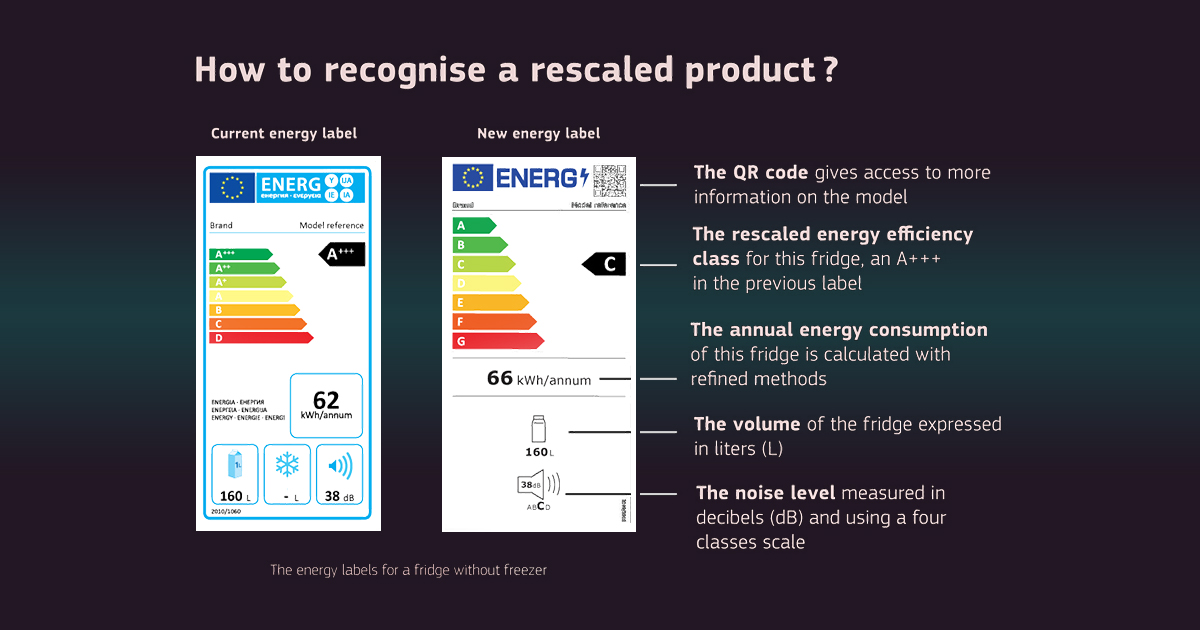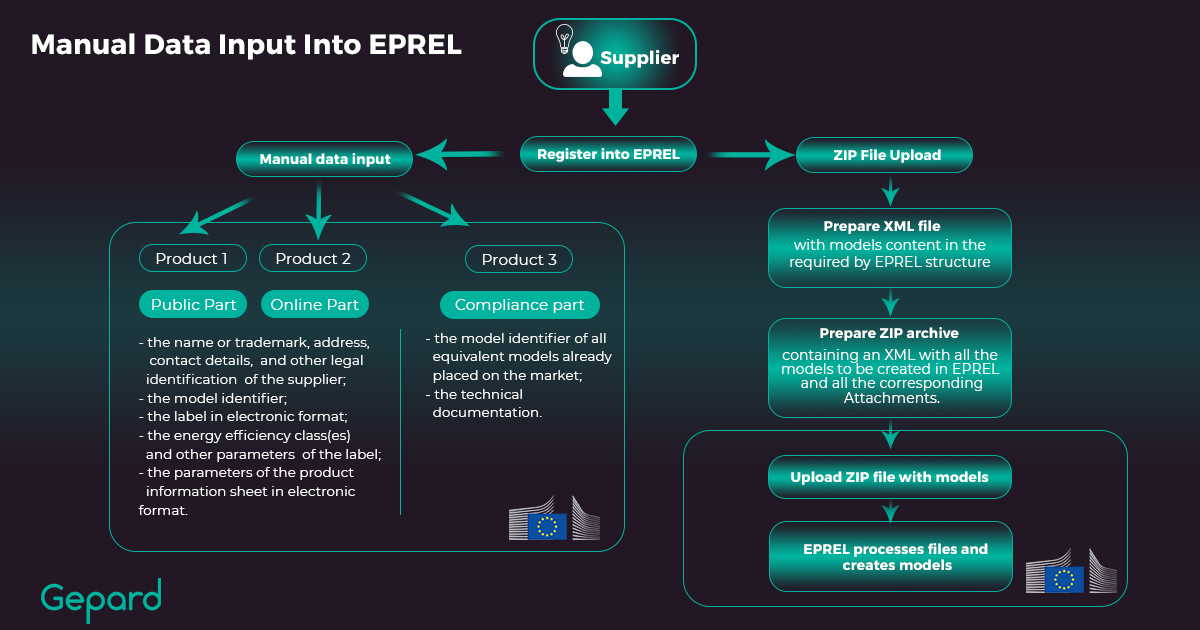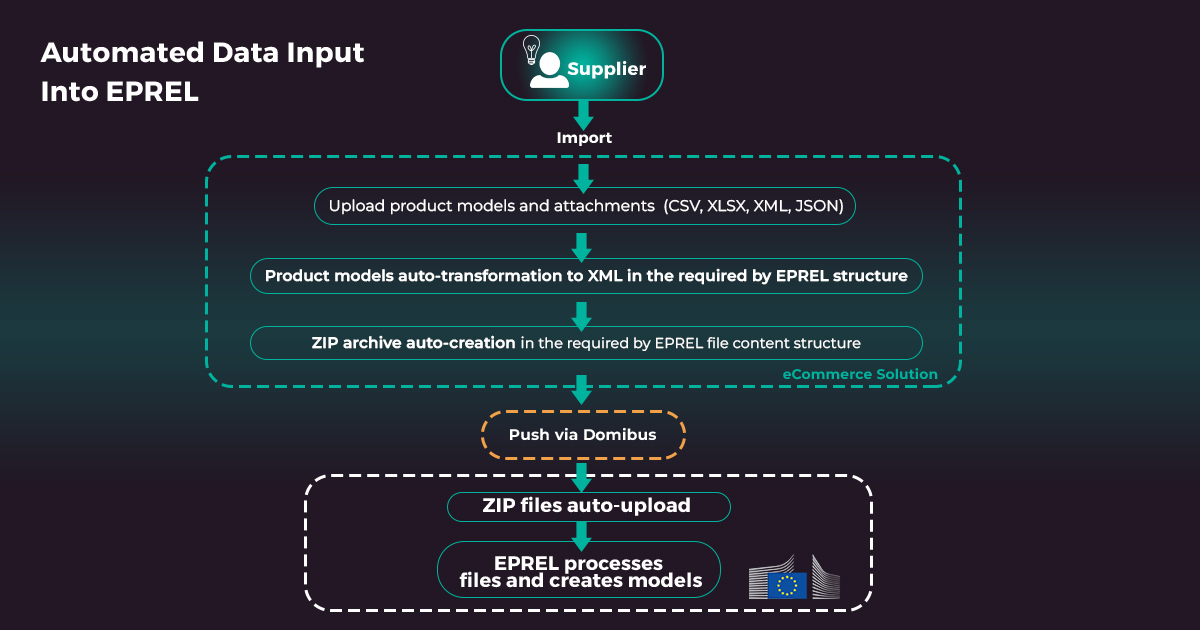Data Entry Into EPREL Database [Overview 2025]
In the fast-paced eCommerce world, we are facing emerging challenges almost every day. Some of them are easy to solve, while others can become difficult puzzles. One of the recent tough nuts to crack for manufacturers is freshly released EPREL requirements. Let’s come straight to the point and discover how to solve the EPREL challenge.
What Is EPREL Database
Generally, the EPREL Database Has Three Main Purposes:
- To support market surveillance authorities in carrying out their tasks under this Regulation and the relevant delegated acts, including enforcement thereof;
- To provide the public with information about products placed on the market and their energy labels, and product information sheets;
- To provide the Commission with up-to-date energy efficiency information for products for reviewing energy labels.
Why Is It Important for Manufacturers?
The EU Framework Regulation 2017/1369 for energy labeling (1 August 2017) has replaced EU Energy Labelling Directive 2010/30/EU. Here is the list of product groups that are required to register in the EPREL database:
- Air conditioners
- Cooking appliances (domestic)
- Dishwashers (household)
- Heaters (space and water heaters)
- Lamps (1 September 2021)
- Local space heaters
- Refrigerating appliances (household)
- Refrigeration (professional)
- Refrigeration with a direct sales function
- Solid fuel boilers
- Televisions
- Tumble dryers
- Ventilation units (residential)
- Washing machines (household)
If you manufacture one of the product categories mentioned above, there are new changes in energy labels you need to comply with.
Get Updated EPREL Energy Labels
Updates in the New Label Model
Here is a brief overview of the changes:
- Three additional classes (E-G) have appeared in the new label model, while the recently used classes marked with “+” will be removed.
- Information about product testing methods has become available in this model version.
- QR-code in the upper right label’s corner has been presented.
- Energy consumption indicators have become more visible.
- Additional pictograms have become more obvious.
EPREL Database Data Entry Model
There are three main sections required for data input:
- Energy label;
- Technical documentation;
- Compliance information.
According to EPREL requirements, there is information available for the public:
- The name or trademark, address, contact details, and other legal identification of the supplier;
- The model identifier;
- The label in electronic format;
- The energy efficiency class and other details from the label;
- Details from the product information sheet in electronic format.

Source: European Commission.
Also, extra information ought to be added by the supplier, but is not visible to the public:
- The model identifier of all equivalent models already placed on the market;
- The technical documentation as specified in Article 12 :
- general description of the model, enough for it to be clearly and easily identified;
- references to the harmonized standards applied or other measurement standards used;
- specific precautions that shall be taken when the model is assembled, installed, maintained, or tested;
- the measured technical parameters of the model;
- the calculations performed with the measured parameters;
- testing conditions as applicable.
What Are the Main Challenges with EPREL?
As with any new legal framework, it’s quite a difficult period for companies to adapt their procedures to become compliant with the issued regulations. Let’s take a look at the most frequent difficulties manufacturers face.
- The lack of direct correspondence between old classes and new ones in the label model.
- The need to adapt your product data to the EPREL database’s data model.
- Complicated technical documentation is hard to understand for non-technical users.
- Time-consuming mass data uploads result in systematic errors.
- The lack of a data validation tool to enable information consistency.
- Complex multi-stage setup to launch the data delivery process.
How to Push Data to EPREL Database?
We can’t deny that setting up the product data delivery to EPREL is a tough process, demanding lots of time, effort, and hands-on experience. Generally, there are two ways how to push data to EPREL: manual and automated.
Approach #1: The Manual Way
In the case of choosing manual data delivery, you will need to register in EPREL, and then manually enter the data for each product according to the EPREL database requirements. You can also upload a ZIP file containing an XML with all the models to be created on EPREL and all corresponding attachments. To do this you will have to adjust your product information to EPREL standards. Find below a detailed scheme with a manual data delivery process overview.

Automated data delivery may seem to be a complicated process; however, it is the most optimal way to ensure smooth data transfer at the first attempt. All you have to do is to choose a reliable eCommerce solution specialized in data syndication. In this case, you need to share product data (CSV, XLSX, XML, JSON) with the integration partner, and product data sheets will be automatically adapted for EPREL taxonomy. Afterward, a ZIP archive will be auto-created and uploaded to EPREL.
Approach #2: The Automated Way
In the case of automated data delivery, there is a tool that will help you to push data to the EPREL database – Domibus – an open-source software used for secure message exchange in the EU. It plays a crucial role in pushing data to EPREL as it provides a secure and reliable communication channel for transmitting the data.
Domibus is responsible for ensuring that the data is encrypted and authenticated during transmission, which is critical for maintaining the confidentiality and integrity of the data. Domibus also handles any errors or failures that may occur during transmission and provides feedback to the sender, allowing them to take appropriate corrective action. Overall, Domibus acts as a middleware that facilitates communication between the sender and EPREL, making it possible to push data to the database securely and efficiently.

Usually, manual data delivery leads to numerous errors, and time loss, and results in a headache for the eCommerce team while automated data input to EPREL helps businesses to concentrate their efforts on more strategic questions.
EPREL Guidelines For Frequently Asked Questions About EPREL Label
What is energy labelling?
Energy labelling is a set of printed stickers that are placed on electrical appliances. Manufacturers are obliged to display European energy labels on products related to A — G classes.
How will the energy labelling directive influence my eCommerce strategy?
Electrical appliance sellers need to register their products into the EPREL EU database and obtain the updated energy labels. For sure, it will take some time to complete your EPREL database access, thus, please take into account that product delivery delays are possible. We advise you to warn your distributors that they may receive the electrical appliances a bit later.
How to get an EPREL QR code?
The new energy labels, which include a QR code, are generated in the EPREL database. The labels are based on the data manufacturers encoded when registering the product. Find more information here.
What am I required to do to obtain EPREL database access?
You should start by creating your organization account. You will need to fill in the mandatory data and then have two options for further product data upload; if you choose the manual registration process you will have to complete all the required fields separately for each product. In case you select a data import in bulk, you will need to create a ZIP file including technical documentation for all models simultaneously. Visit the EPREL forum to get more information.
What is EPREL v2?
EPREL version 2 is a new EU regulation for energy-labeling products implemented in March 2021. The first version of Energy label regulations was issued in 1995. BELT – Boost Energy Label Take up, a project funded by EU Horizon 2020, says that the currently used scale, A+++/G labelling, has become difficult to understand, losing its effectiveness. The higher classes, with many “+”, are too densely populated, and almost no products belong to the “A” class and lower ones as they were banned from the market as a consequence of the Ecodesign requirements.
The European Union has therefore revised and optimized the energy label, initially only for 6 product groups, to meet the user’s needs. Given this, Regulation (EU) 2017/1369 aims to promote the uptake of more efficient energy-related products, repealing Directive 2010/30/EU and the first Directive 92/75/EEC.
EPREL Brexit: Should I obtain the EPREL code for companies registered in the UK?
For sure, this is one of the most common questions these days. From 1 January 2021 products, the UK-based manufacturers are not obliged to input data to the EPREL database if they sell in Great Britain. Otherwise, when selling to EU countries, manufacturers & suppliers need to access the EPREL database in collaboration with a trading partner based in the EU. You can find more information on the UK government’s official website.
What is the relationship between Domibus and EPREL? Is it mandatory to use Domibus for EPREL submissions?
Domibus is an open-source software solution that facilitates the secure and reliable exchange of electronic messages and documents between parties. It is made in compliance with various standards and regulations, including EPREL. Domibus can be used to submit various types of product-related information, such as energy efficiency class, energy consumption, and product features to EPREL databases. Domibus is not mandatory for EPREL submissions. There are other approved communication protocols for submitting product-related information, but Domibus is one of the most commonly used and widely supported options.
How Can Gepard Automate Data Export into EPREL Database?
Gepard PIM & Syndicator empowers manufacturers to automatically deliver the product data retailers and data pools demand. Gepard stands as a middleware automating product data exchange through any format, starting from templates and up to sophisticated EPREL APIs.
Applying a system-to-system approach is one of the most rational ways to solve the EPREL challenge. This method allows you to submit many products in bulk and avoid error-prone, time-consuming manual data upload. Moreover, you do not need to copy-paste your product data in order to adjust it for EPREL’s taxonomy. With Gepard you can use the set of predefined mapping rules to match your data structure with the EPREL’s one.
Instead of spending endless hours trying to understand overwhelming amounts of complicated technical documentation on delivering data to the EPREL database, finding a reliable integration partner is much easier.
Schedule a 45-minute free-of-charge consultation with our eCommerce expert and get answers to your questions.

Just In 3 Clicks!

